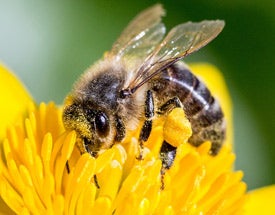Be cautious when dealing with bees. Do not try to remove the bees yourself, and do not call 9-1-1 unless the bees are attacking and someone is in a life-threatening situation. Contact a bee removal expert for swarm and hive removal or relocation.
Bee Removal Responsibility

On Private Property:
Contact a reputable bee removal expert for swarm and hive removal or relocation.
Residents should regularly inspect their home and yard for signs of bees. Swarms look for cavities in trees, eaves and walls as potential nesting sites. These openings should be filled or covered with a solid cover or fine mesh screening. Bees are also attracted to debris such as tires, wood piles or overturned flower pots. When removing any debris, always look before you place your hand under or into something. Use the same caution when working around air conditioners, coolers, electrical boxes or water meters.
Near Utility Boxes and Fire Hydrants:
If bees have made their home in a City-owned water meter, a City-owned water valve box, other City-owned utility boxes, or around a fire hydrant, the City will take responsibility for their removal. Removal of bees in City-owned resources is the only instance in which the City will remove non-threatening bees on private property. For more information or to verify whether a water meter or valve box is City-owned, please call the Water Distribution Division at 480-782-3700.
In City Parks:
In urban areas, it is common to see bees near picnic tables and trash cans. However, if there are threatening swarms or hives of bees in a City park, please call the Parks Division at 480-782-2752.
If you are attacked
- Run as far and as fast as possible, if being attacked.
- Run to shelter in a building or vehicle, if possible.
- Pull your shirt up over your head to protect your eyes and face, but make sure it does not slow your progress.
- Do not swat at the bees or flail your arms, as this may further annoy them.
- Do not jump into a pool (some varieties of bees will wait for you to come up for air)
- Call 9-1-1 if someone is being attacked. If the person being stung by bees cannot run away, cover them with anything you can find. Do what you can to quickly cover any exposed skin or susceptible areas of their body, and then run for help as fast as you can.
If you are stung
- Stings can be life threatening. If you or a family member have been stung, immediately contact Poison Control at 602-253-3334 to determine whether the sting can be managed at home or needs medical attention.
- If you have been stung more than 15 times, or are feeling ill, or if you have any reason to believe you may be allergic to bee stings, it is important to seek medical attention immediately.
- When a honey bee stings, it leaves its stinger in the skin. This kills the honey bee, so it can't sting again, but it also means that venom continues to enter into the wound for a short time. Do not pull stingers out with tweezers or your fingers because this will squeeze out more venom. Instead, scrape them out using your fingernail, the edge of a credit card, a dull knife blade or other straight-edged object.
Bee Swarms
A swarm is a small colony looking to establish a new colony. It may appear as a cloud of bees or a group formed like a ball clinging to a branch. Swarming usually occurs from February through May, and again in October. A swarm can be as large as 60,000 or more bees. If you notice a swarm that is not attacking, walk slowly and quietly away from it and find shelter in a building or vehicle.
Normally, people and bees can coexist, however, with the migration of aggressive Africanized honey bees into the Valley in recent years, experts expect to see an increase in bee incidents. Bee attacks usually occur when bees are swarming or if they are protecting their hive. If someone tries to remove the bees or a hive, agitates the bees by swatting at them, or startling them with the noise from power equipment such as lawn mowers or blowers, a stinging emergency can happen. Attacks frequently occur when a person is mowing the lawn or pruning shrubs and inadvertently strikes a nest. Keep pets and children indoors when using weed eaters, hedge clippers, lawn mowers, chain saws, etc.
Do not try to remove the bees yourself, and do not call 9-1-1 unless the bees are attacking and someone is in a life-threatening situation.
Humane Bee Removal & Relocation Resources
Bees are highly valuable creatures and there are many bee specialists who will provides live, humane bee removal & relocation instead of extermination, thus ensuring that the balance of the environment is kept intact. Search for Humane Bee Removal and Relocation specialists in the Chandler area.



